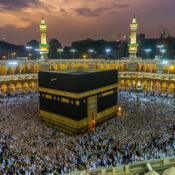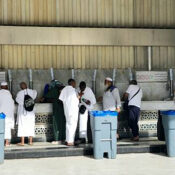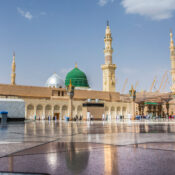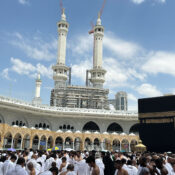
5 Kaaba Facts Muslims Don’t Know
5 Fascinating Facts About the Kaaba Most Muslims May Not Know
The Kaaba is central to every Muslim’s life — the direction for our daily prayers, the focal point of our pilgrimage, and a symbol of unity for the Ummah. Hajj Packages Every time a Muslim bows in salah, no matter where they are in the world, their heart and body turn toward this sacred House of Allah in Makkah. Yet beyond its spiritual importance, Umrah Packages the Kaaba carries a rich history and countless stories that many Muslims might not be aware of.
In this blog, we’ll explore five fascinating and lesser-known facts about the Kaaba that will deepen your appreciation for this timeless sanctuary.
1. The Kaaba Has Been Reconstructed Multiple Times
While we know that the Kaaba was originally built by Prophet Ibrahim (AS) and his son Ismail (AS), what many don’t realize is that it has been rebuilt and renovated several times throughout history. Natural disasters, floods, and the passage of time made reconstruction necessary.
One of the most famous reconstructions happened during the youth of Prophet Muhammad ﷺ. When the Quraysh tribe disagreed over which clan should have the honor of placing the Black Stone (Hajar al-Aswad) back into its position, the Prophet ﷺ wisely resolved the dispute. Umrah Package with Flights He placed the stone on a cloth, asked each clan leader to hold a corner, and then personally guided it back to its place — a moment that reflected his unmatched wisdom and leadership.
The most recent large-scale renovation was carried out in 1996. Engineers reinforced its foundation, replaced stones, and ensured the structure could withstand the millions of pilgrims who circle it every year. This shows us that while the Ka’bah is eternal in meaning, it is also a structure carefully preserved and maintained for generations to come.
2. The Kaaba Once Had Two Doors
Today, the golden Kaaba door we see is a sight that moves hearts to tears. But historically, there was not just one — there were two doors. Abdullah ibn Zubair (RA), a noble companion and leader, renovated the Kaaba in 64 Hijri (683 CE) and introduced two doors: one for entering and another for exiting.
He made this change based on the narration of Aisha (RA), who once told the Prophet ﷺ that she wished she could enter the Kaaba to pray. The Prophet ﷺ replied that if the Quraysh had not been so newly converted, he would have rebuilt the Ka’bah with two doors, lowering it closer to the ground so more people could enter easily.
However, in 75 Hijri, the Umayyad governor Hajjaj bin Yusuf altered this design and sealed one of the doors. Since then, only one entry remains — the door that so many Muslims yearn to touch and pray beside.
3. The Kaaba Wasn’t Always Black
When we imagine the Kaaba, the image of the elegant black Kiswah immediately comes to mind. Yet in earlier times, the cloth that draped the Kaaba wasn’t always black. Different colors were used — including green, red, and even white.
It was during the Abbasid Caliphate that the tradition of using black cloth became the standard. The Abbasids were known for adopting black as a symbol of their dynasty, and this influence extended to the Kaaba’s Kiswah as well.
The Kiswah is replaced annually on the 9th of Dhul Hijjah, the day of Arafah, in a deeply symbolic act that shows both respect for the House of Allah and the continuity of tradition. Each Kiswah is embroidered with Quranic verses in gold and silver threads, reflecting both reverence and beauty.
4. The Kaaba Was Once Open to All Muslims
There was a time when Muslims from across the world could walk through the Kaaba’s doors and pray inside. It was a deeply moving experience for those who were able to enter, offering them a closeness to the sacred site that few can imagine today.
However, as Islam spread and the number of pilgrims increased, practical challenges arose. Safety, crowd management, and preservation became pressing concerns. To protect the sanctity of the Kaaba and ensure order, entry was eventually restricted.
Today, access is limited to a very small number of individuals, usually leaders, dignitaries, and special guests. For the majority of Muslims, the act of making tawaf around the Kaaba — joining millions in a circle of devotion — remains one of the most powerful spiritual experiences in Islam.
5. The Black Stone Was Once Stolen
Perhaps the most shocking historical event concerning the Kaaba is that the Black Stone was once stolen. In 317 Hijri (930 CE), a radical group known as the Qarmatians attacked Makkah, causing chaos and bloodshed. They removed the Black Stone and took it to their base in modern-day Bahrain.
For 23 long years, the Kaaba remained without its most cherished stone. Pilgrims continued their worship, but the absence of the Hajar al-Aswad was a painful reminder of the trials the Ummah faced. Eventually, after negotiations and a hefty ransom, the stone was returned by the Abbasid Caliphate.
The stone, however, was damaged in the process. What remains today are several fragments held together in a silver casing — a physical scar that reminds us of resilience, restoration, and the enduring sacredness of the Kaaba.
Reflecting on the Kaaba’s Legacy
The Kaaba is more than a physical building. It is a living symbol of our faith, a point of unity that transcends geography, language, and culture. Cheap Umrah Packages Every Muslim who faces it in prayer connects to a history that stretches back thousands of years — a history shaped by prophets, companions, rulers, and millions of devoted pilgrims.
Learning about these lesser-known facts not only increases our knowledge but also strengthens our spiritual connection. It reminds us that while the Kaaba has faced trials, reconstructions, and even theft, it remains at the heart of our worship — unshaken, eternal, and divinely protected.
Next time you raise your hands in salah or envision yourself making tawaf, remember these stories. They are part of your heritage as a Muslim, part of a legacy that continues to inspire awe and devotion.







